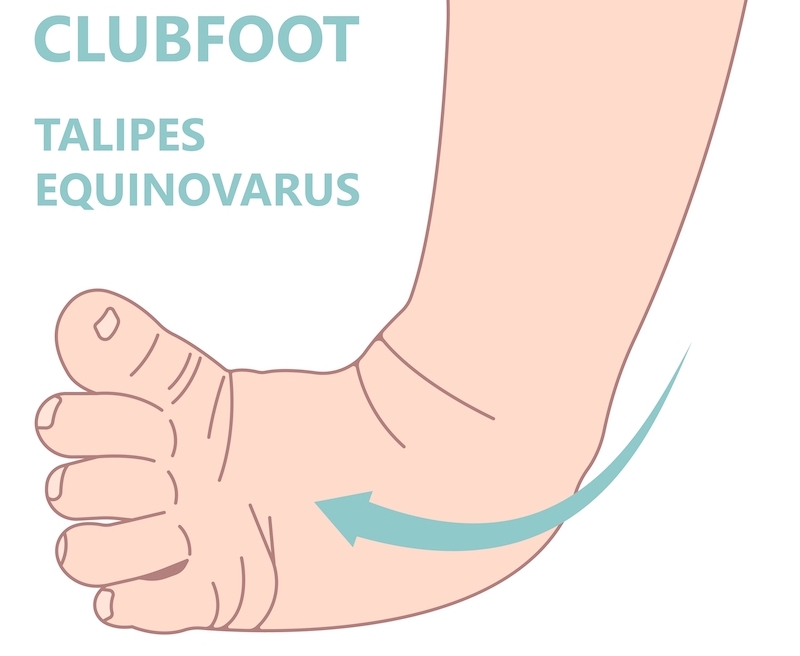Club Foot (Talipes)
Club Foot
Clubfoot or talipes is a congenital condition of the foot and ankle whereby the foot is twisted inwards and downwards.
What is Club Foot?
Clubfoot is a range of abnormalities in the foot and ankle region present at birth. There are four different categories of club foot.
Causes of Club Foot.
Talipes affects as many as 1 in 1000 births in Australia according to healthdirect.gov.au. While the cause of congenital club foot remains unknown, there are several risk factors which include:
- Family history
- Congenital conditions like spina bifida and cerebral palsy
- Environmental factors
- Abnormalities of joint or bone formation
- Smoking during pregnancy
Talipes Equinovarus
A condition whereby your baby’s foot is turned inwards and downwards caused by a shortening of the Achilles tendon (heel cord) and calf muscles, and to a lesser extent your tibialis posterior muscle. Talipes equinovarus is twice as common in males.
Talipes calcaneovalgus
This is a condition in which your baby’s foot appears flat and is turned upwards on the shin bone and points outwards.
The muscles on the front of the shin and outside of the leg are tight and the muscles on the inside of the leg and calf muscles are overstretched and weak. This condition is more common in females.
Talipes equinovalgus
Talipes equinovalgus is usually an acquired condition, where the calf muscles are tight and the Achilles tendon is short, the muscles on the outside of the leg are also tight. The tibialis anterior muscle and tibialis posterior muscle are very weak which leads to a collapsed medial arch.
Talipes equinovalgus is often seen in patients with spina bifida, cerebral palsy and also those with idiopathic flat foot. Symptoms include pain and callous formation over the inside border of your foot due to the foot being so flat.
Talipes calcaneovarus
This is the rarest of the talipes deformities where the heel is turned toward the midline of the body and the front of the foot is elevated.
This form of talipes has shortening of the muscles along the front of the shin and also the tibialis anterior and tibialis posterior muscles and weak calf muscles. Patients with this condition have pain and callous along the outside of the foot.
Presentation of Club Foot
Talipes may present as idiopathic clubfoot (meaning there is no known cause), congenital clubfoot or positional clubfoot (meaning how you formed in the uterus).
Congenital talipes equinovarus is the most common form of club foot. In this classic presentation of clubfoot the entire foot points downwards and the ankle rolls inwards, distinguishing it from pigeon toes where the forefoot rotates inwards.
Congenital club foot is a common foot deformity present from birth. The condition may affect one or both feet and the severity ranges from mild to severe. At its most severe, the club foot is completely rigid.
Club Foot Treatment
Due to your newborn’s bones being made up of mostly cartilage, they are easily manipulated and moldable, therefore most babies will respond well to early intervention.
The standard treatment for club foot was developed in the 1950’s by Ignacio Ponseti. It involves gentle stretching with serial casting to reposition your child’s foot. Your child is placed into a long leg cast so the affected leg and affected foot fall into the correct position.
Ponseti method is not performed at Erica Dash Podiatry, you would need to contact a paediatric physiotherapist to perform this procedure. To achieve successful correction, most children will require between 4-6 plaster casts, and be required to wear the brace until around the age of 4-5 years.
Despite early intervention of the Ponseti technique, some children with clubfoot may still require a small surgical procedure to be performed by an orthopaedic surgeon.
Ongoing Clubfoot Treatment Program
The team at Erica Dash Podiatry are ready to assist you with a range of treatments to maintain a correct foot position and achieve an active life.
We offer services such as same day orthotic therapy for children and adults, dry needling and acupuncture techniques to correct muscle imbalances.
Our podiatrists will write an individual treatment plan including stretching and strengthening exercises to gradually correct muscle imbalances and maintain joint range of motion.
Alternative Podiatry Services

Shockwave Therapy
Shockwave is a great alternative to treatments such as dry needling if you’re needle phobic and not keen on dry needling. We also have effective treatment offers for kids.

Orthotics
If you experience foot, knee or leg pain in your daily activities then a professionally fitted custom orthotic could be the answer to your foot problems.

Dry Needling
Dry needle therapy can be very effective in treating a range of conditions including chronic muscle pain, neuromuscular problems, and sports injuries.
Schedule Your Appointment
Erica Dash Podiatry is family friendly treating a wide range of foot and leg complaints of patients of any age or stage of life - See All Podiatrists
Call us at 02 4367 0177 or fill out our online contact form to schedule your podiatry appointment today!


